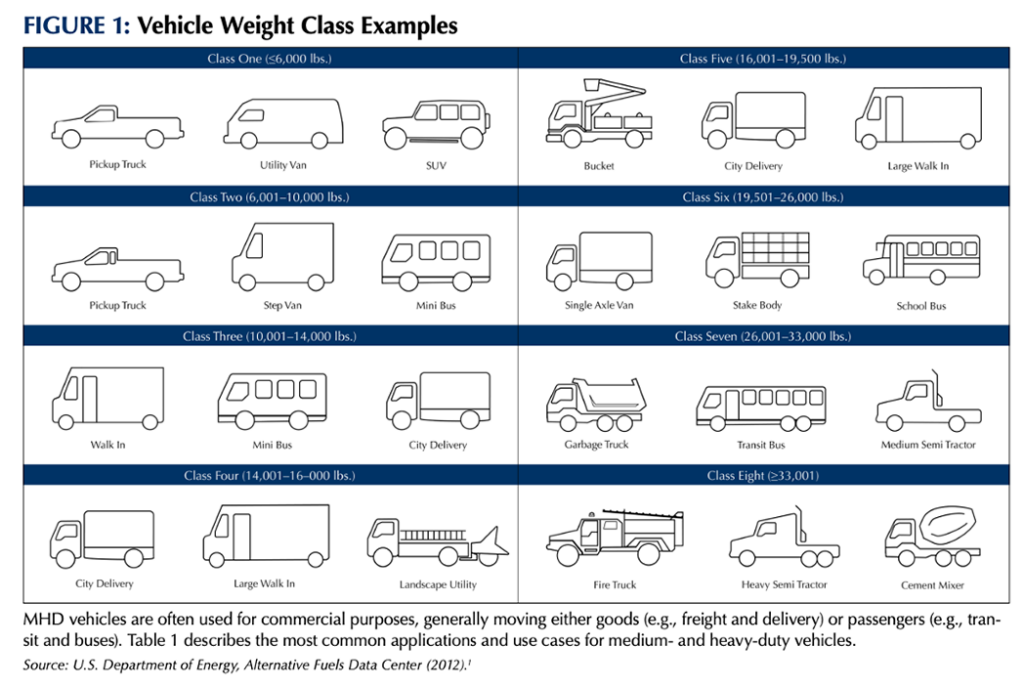Watch for falling emissions from U.S. highways now that the Environmental Protection Agency (EPA) has approved California’s plan to put more zero-emission medium- and heavy-duty (MHD) vehicles on the road. California’s new rules require truck manufacturers to step up sales of zero-emission trucks, buses, and vans each year—while phasing out diesel-powered MHD vehicles. By 2035, zero-emission sales must make up 55 percent of Class 2-3 truck sales, 75 percent of Class 4-8 straight truck sales, and 40 percent of Class 8 tractor sales (see below).
MHD vehicles contribute significantly to U.S. emissions. In 2020, the transportation sector accounted for 27 percent of total U.S. emissions. MHD vehicles accounted for almost one-third of those, even though they made up less than 5 percent of vehicles on the road. California’s standards, combined with federal standards to be released this week for passenger vehicles, could have a big impact on cutting on-road emissions and moving the United States toward its goal of reducing emissions 50–52 percent from 2005 levels by 2030.
There are currently two types of zero-emission vehicle technologies available: battery electric and hydrogen fuel cell. Both use electricity to power a motor, rather than burning fuel in an internal combustion engine. Battery electric vehicles use a large battery to store electricity from the grid, while hydrogen fuel cell vehicles used stored hydrogen, which is converted to electricity through an onboard fuel cell. Each has advantages for different types of medium- and heavy-duty applications.
Grid electricity to power battery electric vehicles is much less expensive than diesel fuel. Battery technology also improves efficiency in vehicles that move slowly and stop frequently, like delivery vans or school buses, that recover some of their energy through regenerative braking.
Hydrogen fuel cells may be better suited for long-haul applications, like tractor-trailers carrying goods across the country because hydrogen is more energy-dense than a battery. This means hydrogen fuel cell trucks can carry more freight over longer distances, using less energy, than their battery or diesel counterparts. Hydrogen fuel cell vehicles can also refuel in minutes instead of hours, making them more efficient to slot into existing transportation system. Currently, California is the only U.S. state with hydrogen refueling infrastructure, and it has only a few operating stations.

California’s new rules, tougher federal emissions standards, state clean truck regulations, federal innovation and deployment funding, and state rebate programs give the United States a road map for decarbonizing MHD vehicles. However, the transportation sector needs additional policies from Congress and federal agencies to overcome all the challenges to MHD vehicle decarbonization.
Fleet operators and drivers may be reluctant to shift to a ZEV model because of greater up-front costs, and because ZEVs operate differently from their diesel-powered counterparts. Their vehicles also need access to scarce U.S. electric charging stations or hydrogen refueling infrastructure, adding to the initial cost.
However, fleet owners can recoup those early investments in the long term because electricity and EV maintenance cost less than diesel fuel and maintenance. Federal incentives and regulations can support the technology development, infrastructure build-out, and expand deployment – lowering costs and making it easier for all MHD drivers to switch to ZEVs.
Communities located near key freight corridors like ports, railyards, and highways will also benefit from the transition to ZEVs. Public health advocates say ZEVs will reduce pollution and diesel emissions in these areas, which often include large populations of low-income residents and people of color.
For a full list of federal policy recommendations, see the brief, Clearing Roadblocks for Zero-Emission Medium and Heavy-Duty Transportation.
The next decade is critical to laying the foundation for the rapid uptake of ZEVs. By 2030, fleet owners must have widespread, reliable access to charging and refueling infrastructure along with the tools and resources to shift their fleets. The U.S. electric grid must also be modernized and hardened to integrate more EVs into the existing transportation system. These transitions must center on justice, and policy and investment must prioritize making communities safer and healthier through access to and deployment of ZEVs.
Eliminating climate pollution from the highest-emitting transportation sector is a formidable challenge, but it also presents an unmistakable opportunity with a clear transition roadmap. With proactive policy at all levels, the United States can accelerate the decarbonization of medium- and heavy-duty vehicle fleets and foster a zero-emission transportation future.
